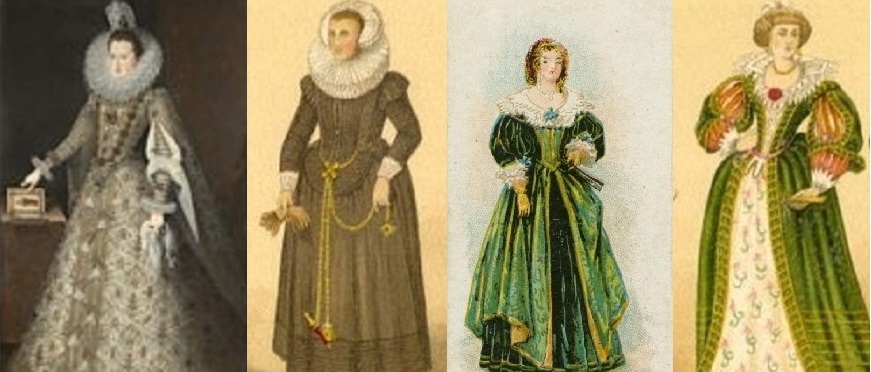Women's Clothing in Stuart History
Posted on 6th February 2023
Clothing varied greatly across Stuart history with differing quality of items worn by working women, puritan women and the wealthy.
Wealthy Clothing
In the early part of Stuart history, fashion was heavily influenced by the Tudors, with farthingale hooped skirts and tight corsets still being popular, but over time there were to be many changes with lace featuring prominently in Stuart clothing for both men and women.
Corset - An upper body item stiffened by using bone and tightly laced to emphasize the lady’s figure and create a desired shape.
Bodice - Long or low waisted garments made of satin and silk that covered from neck to waist with tight full-length sleeves and a lace cuff that matched the ruff. Over time the neckline lowered greatly and in the later Stuart period a triangular piece of fabric, a ‘stomacher’ was used to fill in the gap in the two front edges of the bodice, with the point of the triangle at the bottom. Bodices were bright lavish garments heavily embroidered and trimmed with lace.
In the early 1600’s sleeves became looser. A popular style of sleeve, the ‘Virago’ was strips of fabric looking like a slashed sleeve tied loosely above the elbow making it look like two puffed sleeves.
In the mid 1600’s above the elbow shorter sleeves trimmed with lace became popular, and in the later period three-quarter length sleeves were favoured.
Ruff - High stiffened ruffs of the Tudor period including the cartwheel ruff supported by a wire frame disappeared by about 1613. These were replaced with softer lace collars, initially a wired collar and later with wide flat collars made of linen and bordered with lace.
In the later period when wearing a low-cut bodice, a woman would wear a lace scarf ‘kerchief’ around the neck which was knotted at the front.
Skirts - Became more natural in shape following the abandonment of the farthingale being held in place by a padded roll. Skirts were made from brightly coloured satin and silk, mainly plain colours decorated with embroidery (brocade). They were full length skirts open at the front to reveal an underskirt or petticoat. In the 1680’s they were very long closed skirts (Mantua) that were pulled up at the bottom front and sides and fastened to create flowing bunches. This would then reveal a highly decorated petticoat. The back of the skirt was left long to create a train that would trail behind when walking.
Petticoats - Made of lace and worn under skirts in layers. Needle lace (Reticella) was popular in early Stuart times and would often be stained with yellow starch. During the later period, the lace petticoats would be longer than the skirt and hang out at the bottom as a lace frill. When worn with an open skirt, the petticoat was heavily adorned.
Overgowns - Long full-length unfitted gowns, either long-sleeved, short-sleeved or sleeveless and worn over the bodice and skirt.
Gloves - Made of lace with long lace cuffs to match edging on bodices, skirts and ruffs. The gloves were often long leading up to the elbow.
Cap (Coif) - Made of linen and trimmed with lace covering the top, front and sides of the head. It was worn alone when indoors and worn under a hat when outdoors, finally going out of fashion around 1613.
During much of the 17th century, a wealthy woman’s hair was uncovered as the hairstyle became more important than a headdress.
In the very late 1600’s a ‘fontange’ headpiece became popular; a high headdress supported by a wire framework called a ‘commode’. This framework was then covered in folds of coloured ribbon and lace. The hair, having been curled to the top and sides was pulled back and supported by the ‘fontange’.
Puritan Clothing
A simpler, more modest version of wealthy clothing. A high-necked smock dress with a wide lace collar made of cotton, linen and wool with more sober colours worn including dark greens, browns and a reddish-purple known as ‘murrey’. A linen cap ‘coif’ was worn and the overall outfit had very little adornment.
Working Women’s Clothing
A simple dress made of linen, cotton and wool. Clothing dye was expensive, so these dresses were generally darker than wealthy dress as bright colour dyes were the most expensive. Poorer people were limited to natural dyes, although it was still possible to attain many colours.
Lace was expensive so not normally worn by the working classes. A linen scarf ‘kerchief’ was worn around the neck and knotted at the front.
Tagged as: Junior Stuarts
Share this post:





